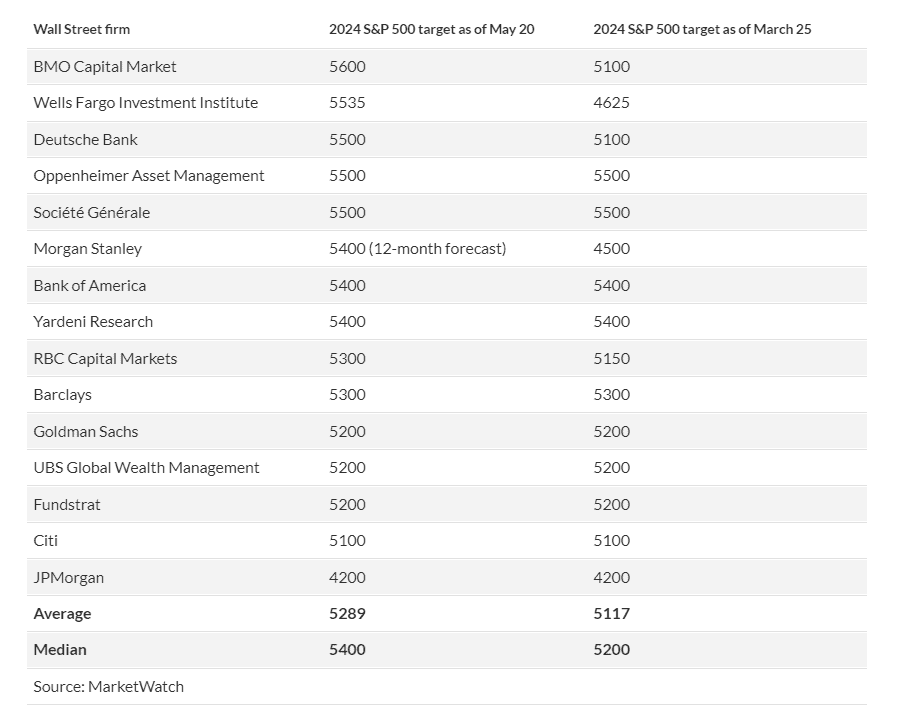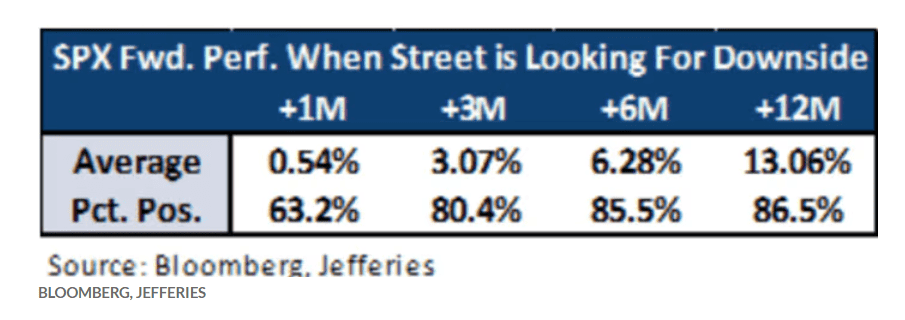The stock market’s renewed record-setting rally has blindsided Wall Street’s top strategists, prompting many to swiftly revise their year-end S&P 500 targets in an effort to keep pace with a surge that has far exceeded expectations from earlier this year.
At least 11 Wall Street firms have lifted their year-end forecasts for the S&P 500 SPX so far in 2024. In the past week alone, BMO Capital Markets and Deutsche Bank revamped their 2024 targets for the large-cap benchmark index, raising them to 5,600 and 5,500, respectively.
At 5,600 points, BMO’s new target appears to be the most bullish forecast among Wall Street’s biggest banks and research firms tracked by MarketWatch — implying an additional upside of more than 5% above Monday’s trading levels.
Heading into 2024, Wall Street firms largely anticipated U.S. stocks to post positive yet underwhelming gains after a robust and forecast-defying 2023. Despite a brief dip in April, stocks have remained on an upward trajectory, with robust gains from megacap technology names driving the three major indexes to multiple all-time highs last week.
See: One of Wall Street’s last remaining bears, Morgan Stanley, has finally capitulated. Here’s its new S&P 500 target.
The rally in May has also forced one of Wall Street’s most prominent bears to turn bullish and bump up his prediction of where equities will go next. Mike Wilson, Morgan Stanley’s chief U.S. equity strategist, said he sees the S&P 500 climbing to 5,400 by the second quarter of 2025.
While it’s not a direct comparison with the other banks’ year-end targets given the different timelines, Wilson’s previous 12-month forecast called for the S&P 500 to be down to 4,500 by the fourth quarter of this year.
Wilson’s shift to a bullish stance on stocks leaves J.P. Morgan’s Dubravko Lakos-Bujas, the bank’s chief global equity strategist, as one of the very few bears left on Wall Street. J.P. Morgan in November set a year-end price target of 4,200 for the S&P 500, representing a potential downside of 21% from Monday’s levels.
The revised estimates from strategists now put their average year-end target for the S&P 500 at 5,289, implying a decline of less than 1% from Monday’s levels, according to MarketWatch calculations. Heading into 2024, the average target was around 5,117 (see table below). Not every bank has yet updated its price target for the S&P 500.

Although some top strategists have been tweaking forecasts higher as the S&P 500 continues to surge, Wall Street in general has “pretty consistently maintained a dour outlook for the market” as the Federal Reserve’s interest-rate outlook remains uncertain, said Andrew Greenebaum, senior vice president of equity research product management at Jefferies.
However, since 2000, the future performance of the S&P 500 is “quite good” when Wall Street is forecasting downside, with the average performance over the next six months sitting at 6.3% and the returns over the following 12 months reaching a cushy 13%, Greenebaum said in a Saturday note (see table below).

To be sure, while top-down estimates present a mixed view of the equities market’s future movement, bottom-up price targets for the S&P 500 paint a more optimistic picture. The bottom-up estimates are calculated by aggregating the median target-price estimates, based on company-level estimates submitted by industry analysts for all the companies in the S&P 500.
John Butters, senior earnings analyst at FactSet, said industry analysts project an 11% increase in the S&P 500 over the next 12 months, with the bottom-up target price for the S&P 500 reaching 5,856.09, he wrote in a Friday note.
At the sector level, the S&P 500’s consumer-discretionary XX:SP500.25 and energy XX:SP500.10 sectors are expected to see the largest price increases over the next 12 months, while the utilities sector XX:SP500.55 is forecast to see the smallest advance, Butters said.
See: Technology stocks are once again leading the way in 2024. Why these ETFs tell a different story.
U.S. stocks were mostly higher on Monday afternoon, kicking off what promises to be a relatively quiet week for economic data. The Dow Jones Industrial Average DJIA was dipping 0.5% after closing above 40,000 for the first time ever on Friday, while the S&P 500 was up less than 0.1%, at 5,306 and the Nasdaq Composite COMP was rising 0.6%, according to FactSet data.

